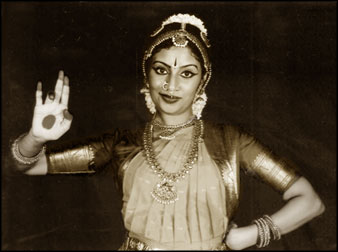Bharatha Natyam and the Tamil culture
by Subashini Pathmanathan
The folk dance form is regarded as Desi dance form, because it
belongs to a certain Pradesha. It reflects religion, regional customs,
and traditions, of the selective area. These folk dance forms differ,
from region to region, place to place, and district to district. Hence
the folk dance varies from place to place.
Similarly, a dance form which transcends the international barriers
acquires worldwide recognition, which is known as Margi. This Margi
dance form is deeply rooted in culture, tradition, philosophy, and
religion.
 |
|
Bharatha Natyam dancer
|
Bhartha Natyam is certainly a margi dance form. It has a well refined
and highly sophisticated art form. Bhartha Natyam is a Tamil Classical
dance form based on Hindu philosophy, and Hindu traditions and Hindu
culture. Besides these, Bharatha Natyam is totally based on the Tamil
Language, yet some of the Kirthanams, songs, surajathi and Varnam items
are in Telugu language, because until 1953, Madras presidency and Andhra
state were together. (Surajathi was only in Carnatic music but not
included in the Bharatha Natyam. But now, some dancers adopt Surajathi
for dance).
Bharatha Natyam is the classical dance form of the Tamils. It has its
own grace, charm, and standing in the international sphere. Wherever
Bharatha Natyam is practised, it is expected to remain the same quality,
and norms.
This particular art form is not only followed and practised in India
alone, but also preserved and practised by the expatriate Tamil
community all over the world. Bharatha Natyam is often referred to as ‘Bharatham’.
This word is derived from the Tamil word “bavam”,”ragam”, and “Thalam’.
Yet Bharatha Natyam is often regarded as the state dance of Tamil
Nadu.
However, the Tamils all over the world preserve and practise, and
carry out this art form.
Some times back, some section of Sri Lankan Tamil expatriate
community wanted to have a separate dance of their own. Even still some
sections of the Sri Lankan Tamils, want to develop a new classical dance
form of their own identity. They regard that Bharatha Natyam is an
Indian Classical dance form.
It actually reveals that they are ignorant, and they do not have any
deep knowledge and depth in the traditional Tamil culture and Tamil
civilization. Such a suggestion is preposterous. They argue that the
style of spoken Tamil language and their social practices differ from
place to place, and region to region. Even it differs from one area to
an other area; within the same country, the Tamil grammar and the Tamil
alphabetical letters remain the same. Similarly, the classical Tamil
music and the Tamil classical dance form must be always one and the same
for all the Tamil community all over the world.
Some self-styled business minded dance teachers introduce numerous,
baseless innovations in the classical Bharatha Natyam dances,which
cannot be regarded as the rich classical oriental dance form of Sri
Lanka. Hence it is impossible to advocate that Sri Lankan Tamil
community must try to develop a classical dance form of their own by
using their own ideas, without any firm footing.
A classical dance form must substantially adhere to the principles of
Natya Sastra. To develop a separate classical dance form one must
understand that a distinct literature and deep philosophy are needed.
Above all a separate music, which must be entirely different from the
classical Carnatic Music is needed. Besides all these, a separate Thala
structure should be found.
It means that such a dance form needs a grammar and idiom of its own.
India is the homeland for 55 million Tamils, and Sri Lanka is
geographically separated by only 18 miles of sea. The Indian influence
has inevitably continued to dominate the Sri Lankan Tamil culture.
There is no doubt that Sri Lankan Tamil community has variety of folk
dances. These folk dances vary from area to area, and province to
province according to the social customs, and practices.
Due to the 30 years of war in this beautiful island, numerous folk (Desi)
dance traditions, and traditional folk dance artistes have migrated, or
died or many of them have abanded their professions due to numerous
reasons. The reasons for the less popularity of the folk dances today
are being shaded by the popularity of the classical dances, and also due
to the development of the modern technology like T.V, Cds, Home video
system, and computer technology. Some of them are trying to revive it.
Some of the traditional folk dance forms have gained state recognition,
and are being preserved, and imparted as a subject at the university
level.
|

